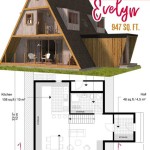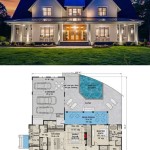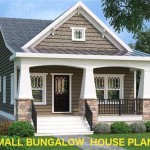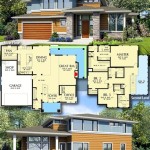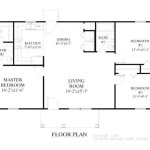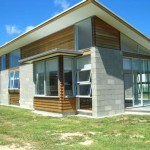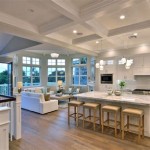A-Frame Home Plans With Garage: Combining Iconic Design with Practicality
A-frame homes, characterized by their steeply angled rooflines forming an "A" shape, offer a distinctive architectural aesthetic. These homes gained significant popularity in the mid-20th century, offering a relatively affordable and structurally sound housing option. Contemporary adaptations of the A-frame design often incorporate modern amenities and address the spatial limitations traditionally associated with the form. One such adaptation is the inclusion of a garage, which adds significant value and functionality to the A-frame home. This article explores the considerations involved in designing and implementing A-frame home plans with attached or detached garages.
The integration of a garage with an A-frame structure presents unique architectural and engineering challenges. The sloping roofline, the often-limited wall space, and the need for efficient circulation patterns require careful planning. However, the resulting combination of the iconic A-frame silhouette with the practicality of a garage can create a visually appealing and highly functional living space.
Addressing Structural Considerations in A-Frame Garage Integration
The primary structural consideration revolves around the load-bearing capacity of the A-frame structure and how the garage interacts with it. The steep roof of an A-frame home typically carries a substantial load, and any alteration, such as attaching a garage, must be carefully engineered to avoid compromising the structural integrity. A qualified structural engineer should be consulted to assess the existing structure and determine the appropriate support mechanisms required for integrating the garage.
If the garage is to be attached directly to the A-frame, the connection points need to be reinforced to distribute the additional weight and stress. This may involve adding structural beams, reinforcing the foundation, or utilizing specialized connectors designed for this purpose. The specific requirements will depend on the size and design of the garage, as well as the existing structural characteristics of the A-frame home.
Detached garages offer an alternative that minimizes the structural impact on the A-frame. In this scenario, the garage is built as a separate structure, typically a short distance from the main house. While this eliminates the direct structural connection, careful consideration must still be given to the overall site plan and the aesthetic harmony between the two structures. The detached garage should complement the A-frame's design, utilizing similar materials and finishes to create a cohesive visual appeal. Furthermore, local building codes regarding setbacks and property lines must be adhered to.
Foundation design is also critical, regardless of whether the garage is attached or detached. The foundation must be adequately sized and reinforced to support the weight of the garage and any vehicles that will be housed within it. Soil conditions should be thoroughly investigated to ensure that the foundation is stable and resistant to settling or shifting.
Optimizing Spatial Planning and Functionality
Space optimization is paramount when designing A-frame home plans with a garage. A-frame homes tend to have limited vertical wall space, particularly on the upper floors. This constraint impacts the layout of the living spaces and necessitates careful consideration of storage solutions and circulation patterns. Integrating a garage into this spatial equation requires creative planning to maximize functionality without compromising the aesthetic appeal.
Attached garages can be designed to incorporate additional living space above or adjacent to the garage, effectively expanding the usable square footage of the A-frame home. This additional space could be used as a guest room, a home office, or a recreational area. Careful attention should be paid to the ceiling height and accessibility to ensure that the space is comfortable and functional. Staircases or other access points should be strategically located to minimize disruption to the existing layout of the A-frame home.
Detached garages offer greater flexibility in terms of size and layout. They can be designed to accommodate multiple vehicles, storage spaces, or even a workshop. The detached nature of the garage also allows for more innovative architectural designs, potentially incorporating features such as a green roof or solar panels. However, the distance between the house and the garage should be carefully considered, particularly in climates with inclement weather. Covered walkways or pathways can provide protection from the elements and enhance the usability of the detached garage.
Interior layout within the garage should be optimized for storage and organization. Shelving, cabinets, and overhead storage racks can help to keep the garage clutter-free and maximize available space. Proper lighting is essential to ensure that the garage is well-lit and safe to navigate. Electrical outlets should be strategically placed to accommodate power tools, electric vehicle chargers, and other equipment.
Aesthetic Considerations and Design Harmony
Maintaining aesthetic harmony between the A-frame home and the garage is crucial for creating a visually appealing and cohesive overall design. The garage should complement the A-frame's iconic silhouette and blend seamlessly with the surrounding landscape. Material choices, colors, and architectural details should be carefully considered to achieve this aesthetic integration.
The exterior of the garage should be designed to match the style and materials of the A-frame home. For example, if the A-frame has a natural wood exterior, the garage should also feature wood siding or a similar material. The color palette should be consistent between the two structures to create a unified appearance. Architectural details such as rooflines, window styles, and trim should also be coordinated to ensure a cohesive design.
Landscaping can play a significant role in integrating the garage into the overall site plan. Trees, shrubs, and other plantings can help to soften the appearance of the garage and create a more natural transition between the structure and the surrounding landscape. A well-designed driveway and walkway can also enhance the aesthetic appeal and improve the functionality of the garage.
The garage door is a prominent feature that should be carefully selected to complement the overall design. A wooden garage door can add warmth and character to the structure, while a metal garage door can provide a more modern and sleek appearance. The style and color of the garage door should be carefully considered to ensure that it enhances the aesthetic appeal of the A-frame home.
Furthermore, consider incorporating elements that visually connect the house and the garage. This could be achieved through a covered walkway with matching roof lines, similar window designs, or shared landscaping features. These subtle connections help to unify the two structures and create a sense of cohesion.
Lighting fixtures on the exterior of the garage should also be carefully selected to complement the overall design. Warm, inviting lighting can enhance the curb appeal of the A-frame home and create a welcoming atmosphere. Consider using motion-sensor lights for added security and energy efficiency.
Finally, incorporating sustainable design principles into the garage construction can further enhance the overall appeal and functionality of the A-frame home. This could include using recycled materials, incorporating energy-efficient lighting and insulation, and utilizing rainwater harvesting systems. Sustainable design practices not only reduce the environmental impact of the construction but also can add value to the property.
Designing A-frame home plans with garages requires a comprehensive approach that addresses structural, spatial, and aesthetic considerations. Consulting with experienced architects, engineers, and contractors is essential to ensure that the project is executed safely and effectively. By carefully planning and implementing the design, homeowners can create a functional, aesthetically pleasing, and structurally sound living space that combines the iconic charm of the A-frame with the practicality of a garage.

A Frame House Plans Free Cabin Floor

A Frame House Plans Everything You Need To Know Field Mag

A Frame House Plans Floor Cool

A Frame House Plans Floor Cool

15 A Frame House Plans That You Need To See Believe

A Frame Home Plans Custom Design Great House

Plan 41165 Cottage Style With 2 Bed 3 Bath Car Garage

A Frame House Plans Floor Cool

A Frame Floor Plan 1 Bedrm Bath 908 Sq Ft 146 1841

Cozy A Frame House Plans Blog Eplans Com

